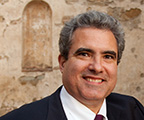Theoretical Comparison of Direct-Sampling vs. Heterodyne RF Receivers

Speaker: Ramon (Ray) Gomez, Ph.D.
Affiliation: Consultant / Adjunct Professor, UC Irvine
Abstract:
An intuitive high-level argument is presented suggesting that direct-sampling radio frequency (RF) receivers using Nyquist analog-digital converters can be as power-efficient as analog heterodyne receivers for equal dynamic range specifications, at least at lower RF frequencies well below the ft of the IC process. System planning for direct-sampling receivers is reviewed, highlighting dBFS/Hz as an intrinsic measure of dynamic range, independent of channel and Nyquist bandwidths. Power dissipation versus dynamic range for recently reported heterodyne and direct-sampling receivers is examined and compared.
Biography:
Ramon (Ray) Gomez (M’81–SM’10) received his Ph.D. in Electrical Engineering from UCLA in 1993. He was staff engineer at TRW in Redondo Beach, California from 1982 to 1986, designing high-performance radios for aerospace applications. From 1993 to 1995, he was a member of the disk-drive read channel design team at Cirrus Logic in Austin, Texas. From 1995 to 2017, Ray worked at Broadcom in Irvine, California focusing on CMOS RF circuits for cable, satellite and broadcast television receivers, cable modems, and MoCA home networking. His recent work has included development of circuits and architectures for direct-sampling RF transceivers, digitally-assisted RF circuits, and efficient broadband amplifiers. He is presently a consultant and an adjunct professor with the EECS Department, University of California, Irvine. Ray was recognized as a Broadcom Fellow in 2006 for his contributions to CMOS television tuner design.
For more information, contact Prof. Asad A. Abidi (abidi@seas.ucla.edu)
Date/Time:
Date(s) - Jun 01, 2018
11:00 am - 1:00 pm
Location:
E-IV Faraday Room #67-124
420 Westwood Plaza - 6th Flr., Los Angeles CA 90095
